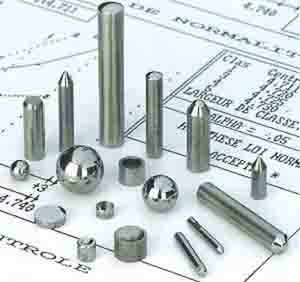Tungsten Carbide Facts
What is carbide?
In chemistry, carbide is a compound composed of carbon and a less electronegative element. Carbides can be generally classified by chemical bonding type as follows: salt-like, covalent compounds, interstitial compounds, and "intermediate" transition metal carbides. Examples include calcium carbide, silicon carbide, tungsten carbide (often called simply carbide), and cemented, each used in key industrial applications. The naming of ionic carbides is not systematic.
What is tungsten carbide?

Tungsten carbide (WC) is an inorganic chemical compound (specifically, a carbide) containing equal parts of tungsten and carbon atoms. Colloquially, tungsten carbide is often simply called carbide. In its most basic form, it is a fine gray powder, but it can be pressed and formed into shapes for use in industrial machinery, tools, abrasives, as well as jewelry. Tungsten carbide is approximately three times stiffer than steel, with a Young's modulus of approximately 550 Gar and is much denser than steel or titanium. It is comparable with corundum (α-Al2O3) or sapphire in hardness and can only be polished and finished with abrasives of superior hardness such as cubic boron nitride and diamond amongst others, in the form of powder, wheels, and compounds.
Tungsten carbide facts are an inorganic chemical compound containing equal parts of tungsten and carbon atoms. Colloquially, tungsten carbide facts are often simply called carbide. In its most basic form, it is a fine gray powder, but tungsten carbide facts can be pressed and formed into shapes for use in industrial machinery, tools, abrasives, as well as jewelry.
Tungsten carbide facts are approximately three times stiffer than steel, with a Young's modulus of approximately 550 GPa, and is much denser than steel or titanium. Tungsten carbide facts are comparable with corundum (α-Al2O3) or sapphire in hardness and can only be polished and finished with abrasives of superior hardness such as cubic boron nitride and diamond amongst others, in the form of powder, wheels, and compounds.
Tungsten Carbide Facts of Chemical Properties
There are two well characterized compounds of tungsten and carbon, WC and tungsten semi carbide, W2C. Both compounds may be present in coatings and the proportions can depend on the coating method. WC can be prepared by reaction of tungsten metal and carbon at 1400–2000 °C. Other methods include a patented fluid bed process that reacts either tungsten metal or blue WO3 with CO/CO2 mixture and H2 between 900 and 1200 °C. Chemical vapor deposition methods that have been investigated include: WC can also be produced by heating WO3 with graphite in hydrogen at 670 °C following by carburization in Ar at 1000 °C or directly heating WO3 with graphite at 900°C.
At high temperatures WC decomposes to tungsten and carbon and this can occur during high-temperature thermal spray, e.g. high velocity oxygen fuel (HVOF) and high energy plasma (HEP) methods.
Oxidation of WC starts at 500–600 °C. It is resistant to acids and is only attacked by hydrofluoric acid/nitric acid (HF/HNO3) mixtures above room temperature. It reacts with fluorine gas at room temperature and chlorine above 400 °C (752 °F) and is uncreative to dry H2 up to its melting point.
WC has been investigated for its potential use as a catalyst and it has been found to resemble platinum in its catalysis of the production of water from hydrogen and oxygen at room temperature, the reduction of tungsten trioxide by hydrogen in the presence of water, and the summarization of 2,2-dimethylpropane to 2-methylbutane. It has been proposed as a replacement for the iridium catalyst in hydrazine powered satellite thrusters.
Tungsten Carbide Facts of Physical properties
Tungsten carbide is high melting, 2,870 °C (5,200 °F), extremely hard (~9 Mohs scale, 1700-2400 Vickers number) with low electrical resistivity (~2×10−7 Ohm·m), comparable with that of some metals (e.g. vanadium 2×10−7 Ohm·m).
WC is readily wetted by both molten nickel and cobalt. Investigation of the phase diagram of the W-C-Co system shows that WC and Co form a pseudo binary eutectic. The phase diagram also shows that there are so-called η-carbides with composition (W,Co)6C that can be formed and the fact that these phases are brittle is the reason why control of the carbon content in WC-Co hard metals is important.
Tungsten Carbide Facts of Structure
α-WC structure, carbon atoms are gray. There are two forms of WC, a hexagonal form, α-WC (hP2, space group P6m2, No. 187), and a cubic high-temperature form, β-WC, which has the rock salt structure. The hexagonal form can be visualized as made up of hexagonally close packed layers of metal atoms with layers lying directly over one another, with carbon atoms filling half the interstices giving both tungsten and carbon a regular original prismatic, 6 coordination. From the unit cell dimensions the following bond lengths can be determined; the distance between the tungsten atoms in a hexagonally packed layer is 291 pm, the shortest distance between tungsten atoms in adjoining layers is 284 pm, and the tungsten carbon bond length is 220 pm. The tungsten-carbon bond length is therefore comparable to the single bond in W(CH3)6 (218 pm) in which there is strongly distorted trigonal prismatic coordination of tungsten. Molecular WC has been investigated and this gas phase species has a bond length of 171 pm for 184W12C.
If you have any interest in tungsten carbide facts, please feel free to contact us by email: sales@chinatungsten.com, sales@xiamentungsten.com or by telephone: +86 592 5129696.






 sales@chinatungsten.com
sales@chinatungsten.com